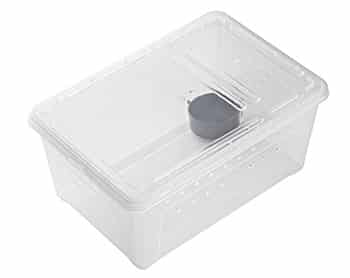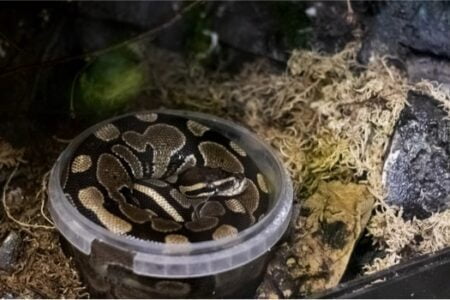If you’re taking your pet snake to the vet or moving house, you’ll need a high-quality snake travel carrier. But snakes become stressed when moved around, and when in unfamiliar places.
Take a secure plastic tub and create an air hole. Line the tub with a substrate and give it a spray. Affix a thermometer to the inside of the tub that’s visible from the outside. Place your pet in a snake bag before putting it in the tub. In cold weather, supply a hand warmer.
This is one of the best ways to transport snakes, but it’s not the only way that a snake can be moved safely. You could also use a portable plastic terrarium, a shift box, or a snake bag.
Best Way to Transport Snakes
Snakes are more difficult to transport than other pets. While you can comfort most pets, you can’t comfort or offer snakes treats to make them happy. There’s no way around the fact that they don’t enjoy traveling.
Traveling is dangerous for snakes. They have exacting requirements for their temperature and humidity. If these aren’t met, the snake can die quickly. This applies in very hot and cold environments.
There are ways to transport snakes. Some are better than others, but your choice should depend on the reason for the journey and the weather conditions. These modes of snake transport are the most common:
- Snake bags. These are drawstring cloth bags that are comfy and prevent the snake from getting stressed.
- Portable plastic terrariums. Terrariums come in a variety of sizes and are small enough to travel with.
- Basic plastic tubs. Tupperware tubs with air holes in can work
- A snake transport box/shift box. These are a tool developed to transport venomous snakes, but they can be used for any snake.
The best way to transport snakes is to put them in a bag, and then put the bag in a portable terrarium. This provides security and strength, plus a place for the snake to hide and feel secure.
Snake Bags
Snake bags have been the go-to method of transporting snakes for decades. The typical bag is made from breathable fabric. Often printed on the fabric is a warning, such as ‘Live Snake Inside.’ The bag will have a drawstring that can be tied shut so the snake can’t escape.

If you don’t have a dedicated snake bag, you can use a pillowcase. Get the snake inside using your snake hook and tie the top of the pillowcase shut.
| Advantages | Disadvantages |
|---|---|
| Snakes feel safe in enclosed spaces | The bag won’t protect the snake from bumps and bruises |
| Snake bags are less expensive and easy to find online | The bag won’t protect the snake from getting too hot or too cold |
| Snake bags are easy to use, especially if you have a snake hook | You can’t see how the snake is doing without opening the bag |
| If the snake goes to the toilet, it will make a real mess |
Plastic Tubs
You could also consider using a plastic tub. A small plastic container would be fine for this purpose. The snake sits inside as it sits inside its enclosure.
These don’t have to be bought specifically for your snake. Any Tupperware tub would do. If the snake is going to be inside for a long period of time, you should drill small holes in the top so that it can breathe properly.

Pick a tub that has a lid that locks into place. This will stop the snake from getting loose while you’re transporting it.
| Advantages | Disadvantages |
|---|---|
| You can check on your snake to see if it’s happy if the tub is see-through | If the snake can see all around, it may feel vulnerable and get defensive |
| You may have a suitable tub at home. | Snake might not fit in the tub |
| You can put things in the tub with the snake, such as a substrate | The lid on the tub may not be as secure as you think, and the snake could get out. |
| Plastic retains heat and humidity | Large tubs are more expensive than a snake bag. |
Plastic Terrariums
Terrariums come with a lid with air holes. Some have a lid that can be secured in place, which you’ll need. Line the terrarium with a substrate and give it a spray before transporting your snake. While most terrariums are designed to stay at home, some are made with travel in mind.
| Advantages | Disadvantages |
|---|---|
| You can find a portable terrarium that’s the right size | A terrarium is larger than a tub or bag, so it may be hard to carry |
| The terrarium can be adjusted to meet the snake’s needs, i.e. with humidity and temperature. | Some terraria don’t come with secure, fastening lids. The snake could get loose |
| If you provide enrichment inside the enclosure, it will feel safe and secure. | |
| Plastic tubs retain heat and humidity | |
| You can see through the clear plastic sides so that you can keep an eye on the snake and its temperature |
Snake Shift Box
Shift boxes are custom-made by breeders and owners. They’re usually made by people who own venomous snakes. They prioritize safety, both when getting the snake in the box, and when traveling.
The idea of a shift box is that you put the box in the snake’s enclosure. The snake will get inside on its own, so you don’t have to pick it up. This isn’t necessary with non-venomous snakes unless you have a particularly aggressive specimen.
The boxes are usually wooden in construction. They have a lid on hinges that opens upwards that can be secured with a padlock. There is a hole in the front that the snake gets in through. This hole can be secured shut.
The box itself can be set up with substrate, moisture, and a thermometer.
| Advantages | Disadvantages |
|---|---|
| The emphasis of a shift box is on safety | You can’t buy shift boxes at online stores. |
| A shift box can be customized | To get a shift box you need to make it yourself, or contact a snake owner/breeder. The quality may be lower than if a manufacturer made it. |
How to Transport a Snake
There is no ideal method to transport a snake, but this is the one that most snake owners use, and which is generally successful. Here’s how:
- Prepare your terrarium or tub by drilling air holes
- Fit the tub with a small thermometer that’s visible from the outside
- Line the tub with a layer of substrate
- Give the tub a spray so that the humidity level stays high
- Get the snake into the bag
- Put the snake bag into a plastic terrarium or tub. Leave the drawstring of the bag open, so that the snake can get in or out if it wants to do so
- Travel with the tub in the shade rather than in the sun
At all times, keep the snake in the shade. While it may be slightly too cool, a sealed tub will overheat quickly if left in the sun.
According to the Journal of Experimental Biology, snakes have a limited ability to thermoregulate using blood flow. But this is nowhere near as effective as the thermoregulation a mammal can achieve.
When you arrive at your destination, you’ll have to get the snake out. The snake will likely be irritated: it’s in an unfamiliar environment with new smells, and has spent the last several hours being jostled around.
We recommend using a snake hook. This will enable you to take the snake out of its travel bag or container with the minimum of fuss.

